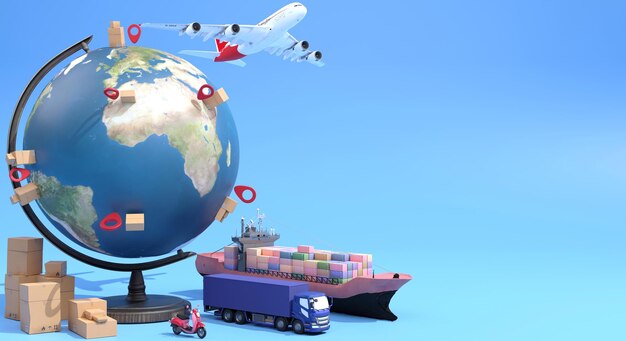International shipping is a must for small businesses looking to tap into new markets and grow globally. But let’s be real – optimizing your strategy isn’t easy, especially when small companies often get stuck paying higher shipping prices than big guys for lower reliability.
In fact, high shipping costs are the number one pain point reported by SMBs. And with so many vendors offering confusing rates and service levels, less than half of small businesses (44%) consider themselves loyal to just one carrier partner.
To grow globally, SMBs need strategic approaches to secure affordable rates and dependable service on international shipments. This guide will walk through key strategies – from assessing your needs to leveraging tech, negotiating win-win partnerships, and continuously optimizing.
With the right strategic approach, small businesses can cut through the noise, level the playing field, and ship products worldwide with maximum efficiency.
Assess Your Needs And Shipping Options
First, take time to determine your product specifications, average shipment volumes, and target international destination countries. Get very clear on the key details related to what you will be shipping. Consider factors like:
- Product size
- Weight
- Type of goods
- Temperature sensitivity
- Special handling needs
Understanding these specifications will inform which carriers can properly handle your items.
Next, research the major carrier options such as national postal services, private couriers, and freight forwarding companies. A freight forwarder will act as an intermediary that arranges shipments and handles paperwork on behalf of businesses, leveraging volume discounts and established relationships that can benefit small businesses lacking scale.
For each option, make sure to consider the trade-offs across factors such as cost, transit speed, tracking capabilities, reliability, and customer service. There is no one-size-fits-all solution, so gather intel on the pros and cons of each carrier.
It’s important to maintain flexibility at this stage, as your international shipping needs will likely evolve over time as your business grows. The carrier providing the best solution now may not remain the ideal choice at larger volumes. Be open to trying different services to find the best fit rather than marrying yourself to just one option initially. The goal is to have the agility to pivot your shipping strategy as requirements change.
Get Your Shipping Documents in Order
International shipping involves navigating a wide range of documentation requirements and regulations for exporting and importing goods across borders. There are several key documents small businesses need to ensure they have in order:
- Commercial Invoices – These invoices provide information about the transaction and goods for customs, including descriptions of products, values, and quantities.
- Certificates of Origin – These certificates state where products were manufactured and underwent a substantial transformation. Some countries require them for preferential duty rates.
- Export Packing Lists – Outlines the contents of each shipment and helps support customs verification.
- Shipper Export Declarations – Required for high-value or controlled shipments being exported. Filed electronically with the Census Bureau.
- Insurance Certificates – Proof of insurance coverage on shipments.
Proper classification of your goods via Harmonized System (HS) codes is also essential to ensure accurate duties and tariffs. As such, take the time upfront to get your documentation in order to avoid customs delays or penalties down the line. The paperwork may be tedious but is a necessity of international trade.

Get Efficient With Shipping Technology
Technology and software tools are a must for small businesses looking to streamline and add transparency to their international shipping workflows. Online freight platforms, for example, enable you to instantly compare rates across multiple carriers with a few clicks. This is way easier than contacting each carrier individually to source quotes. Many platforms also handle booking and documentation, and provide shipment tracking – all of which are huge time savers.
Customs pre-clearance tools are another smart option that lets you digitally submit paperwork before goods arrive to expedite clearing shipments on the destination side. This cuts down on frustrating customs delays at the border. Some pre-clearance tools even integrate with your sales order system for seamless information sharing.
And don’t forget about Transportation Management Systems (TMS). These are centralized software dashboards to manage your end-to-end shipping workflows – from planning to execution and monitoring. TMS delivers visibility into the global movement of your goods.
Integrating your inventory management system with automated shipping profiles is another efficiency boost. This automatically prints compliant shipping labels and commercial invoices as you fulfill orders. No manual work is required.
Continuously Fine-Tune Your Strategy
International shipping requires ongoing fine-tuning as your business grows. With this in mind, it’s crucial to regularly analyze your metrics and costs to identify opportunities for improvement.
Routinely pull reports on recent shipments – were deliveries on time? Were costs as expected? Did any hiccups occur at customs? Breaking down your actual performance helps reveal process pain points and opportunities.
From there, use those insights to tweak your approach. Maybe certain trade lanes are unprofitable based on origin/destination costs. Can you negotiate better rates? Are you using suboptimal shipment modes? Could customs clearing be expedited?
Essentially, be proactive about reviewing metrics and then optimizing based on what the data shows. Refine your workflows, carrier partnerships, and tools over time as your needs change. And definitely stay on top of regulation changes in your target countries. International shipping requires diligence, but the payoff for continuously fine-tuning your strategy is huge – improved reliability, lower costs, and happier customers.
Final Thoughts
Optimizing international shipping may feel daunting, but breaking it down into strategic steps makes it manageable for any small business. Assess your needs, leverage helpful technologies, build win-win partnerships, and never stop analyzing and fine-tuning. It’s a process of continuous improvement.
With the right strategic approach, you can access the same affordable rates and reliability as larger companies. And remember, you don’t have to go it alone – tap experts like freight forwarders to help craft your strategy. Be proactive and you can ship globally with ease.
Read Also:




























